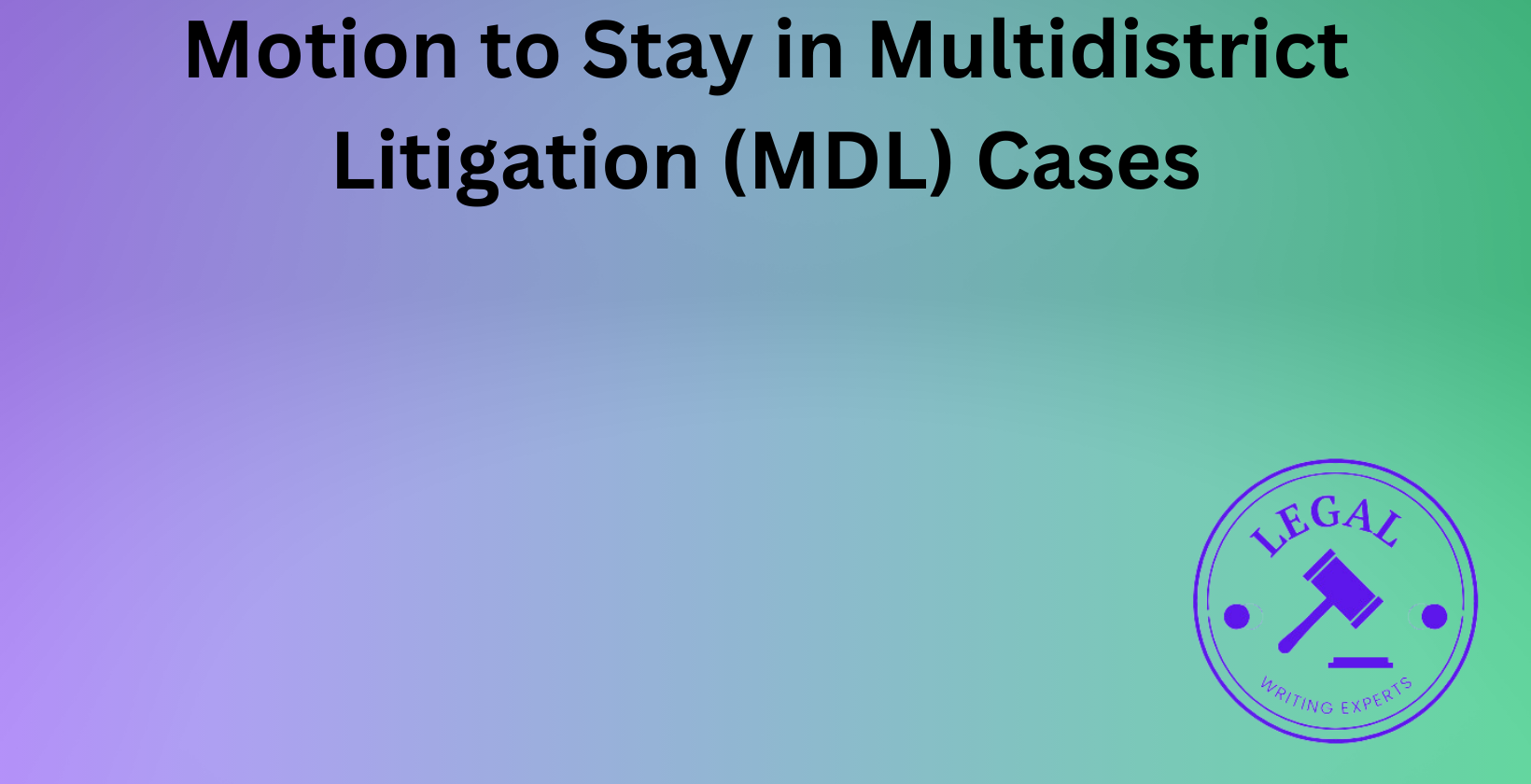Motion to Stay in Multidistrict Litigation (MDL) Cases
Written by
Jessica E
March 17, 2025 · 8 min read

A Motion to Stay in Multidistrict Litigation (MDL) cases is a legal request to temporarily halt proceedings. This motion is commonly used to pause discovery, legal filings, or enforcement actions while awaiting a critical ruling, settlement negotiations, or other significant legal developments. Courts consider motions to stay to promote efficiency, prevent unnecessary costs, and avoid inconsistent rulings. Understanding the legal requirements, drafting process, and procedural aspects of filing a Motion to Stay is essential for attorneys and litigants involved in MDL cases.
What Is a Motion to Stay in Multidistrict Litigation (MDL) Cases?
A Motion to Stay in Multidistrict Litigation (MDL) cases is a formal legal request to pause court proceedings. It is typically filed by one or more parties in a case to delay certain actions, such as discovery, motions, or trial schedules. The purpose of this motion is to allow courts to resolve preliminary legal issues, consider settlement discussions, or address higher court rulings that may impact the case.
How Does a Motion to Stay Affect MDL Proceedings?
A Motion to Stay affects MDL proceedings by temporarily suspending specific legal actions. When granted, this motion can delay discovery, halt deadlines, and postpone hearings until the stay is lifted. Courts issue stays to maintain judicial efficiency and prevent unnecessary litigation efforts, particularly when an appellate decision or settlement negotiations may significantly alter the case’s trajectory.
Why Would a Party File a Motion to Stay in an MDL Case?
A party files a Motion to Stay in an MDL case to prevent unnecessary legal expenses, avoid conflicting rulings, or allow time for related proceedings to be resolved. Common reasons include waiting for appellate court decisions, settlement discussions, ongoing regulatory reviews, or parallel litigation that may affect the case. Courts consider whether granting the stay serves judicial efficiency and prevents prejudice against any party.
How to Write a Motion to Stay for an MDL Case?
Writing a Motion to Stay for an MDL case requires a clear legal argument, relevant case law, and supporting facts. The motion should include a case caption, introduction, legal basis for the request, supporting authorities, and a conclusion. A well-drafted motion demonstrates how granting the stay will promote efficiency and fairness. Hiring a legal document writer or a legal drafting service ensures that the motion complies with court requirements and persuasive legal reasoning.
What Are the Legal Requirements for a Motion to Stay in MDL?
The legal requirements for a Motion to Stay in MDL include demonstrating good cause, citing applicable case law, and showing that granting the stay will not unduly prejudice the opposing party. Courts evaluate factors such as judicial economy, hardship to the parties, and the potential impact of external legal proceedings. A strong legal draft includes clear arguments supported by legal precedent and procedural rules.
Where to Hire a Legal Writer to Draft a Motion to Stay for MDL?
Hiring a legal writer to draft a Motion to Stay for MDL can be done through legal research companies, freelance legal research services, or legal document drafting services such as Legal writing Experts. Many online platforms offer legal writing services, where experienced professionals create legal documents that meet court standards. It is essential to hire a legal writer with expertise in MDL cases to ensure accuracy and compliance with procedural rules.
How to File a Motion to Stay in Multidistrict Litigation?
Filing a Motion to Stay in Multidistrict Litigation requires submitting the motion to the court overseeing the MDL. The filing process includes drafting the motion, serving copies to all parties, and complying with court rules for motion practice. Some jurisdictions require electronic filing, while others accept paper submissions. Courts may schedule a hearing to review the motion before issuing a ruling.
When Should a Motion to Stay Be Filed in an MDL Case?
A Motion to Stay should be filed in an MDL case when an external factor significantly affects ongoing proceedings. Common scenarios include awaiting an appellate ruling, engaging in settlement discussions, pending regulatory actions, or overlapping cases in other jurisdictions. Filing promptly ensures that parties avoid unnecessary legal expenses and procedural conflicts.
What Happens After a Motion to Stay Is Granted in MDL?
After a Motion to Stay is granted in MDL, all affected legal actions are paused until the stay is lifted. The court sets conditions for the stay, such as a specific duration or triggers for resuming proceedings. Litigants must monitor developments that may impact the stay’s status and prepare for resumption once the court determines the appropriate next steps.
How Does the Judicial Panel on Multidistrict Litigation (JPML) Handle Motions to Stay?
The Judicial Panel on Multidistrict Litigation (JPML) handles Motions to Stay by reviewing the legal grounds, potential impact on coordinated proceedings, and the interests of judicial efficiency. The panel considers whether the stay aligns with the purpose of MDL, which is to consolidate complex litigation for streamlined adjudication. Courts defer to JPML rulings in determining whether a stay serves the broader interests of multidistrict litigation.


